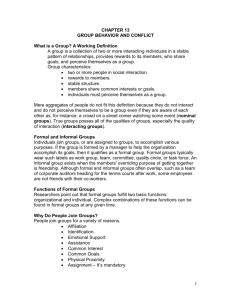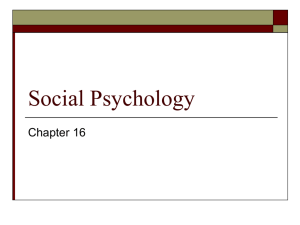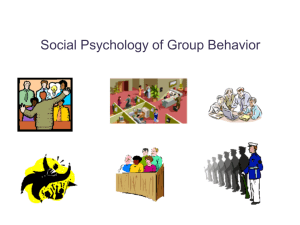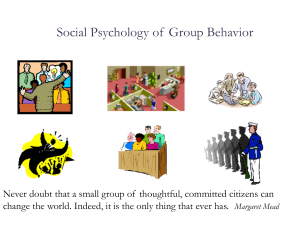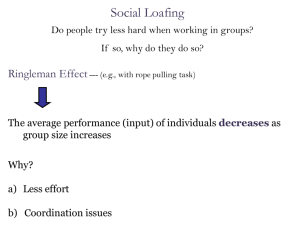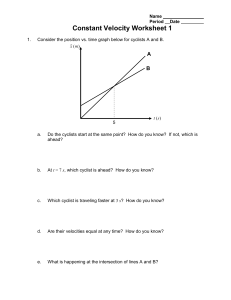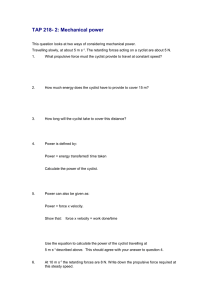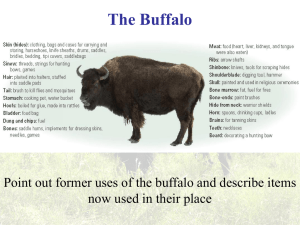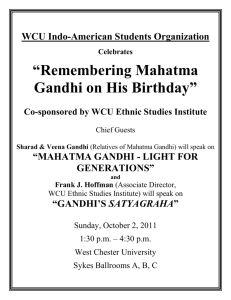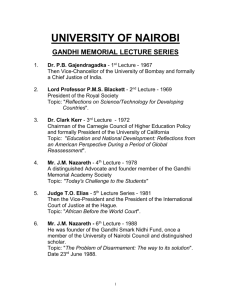File
advertisement
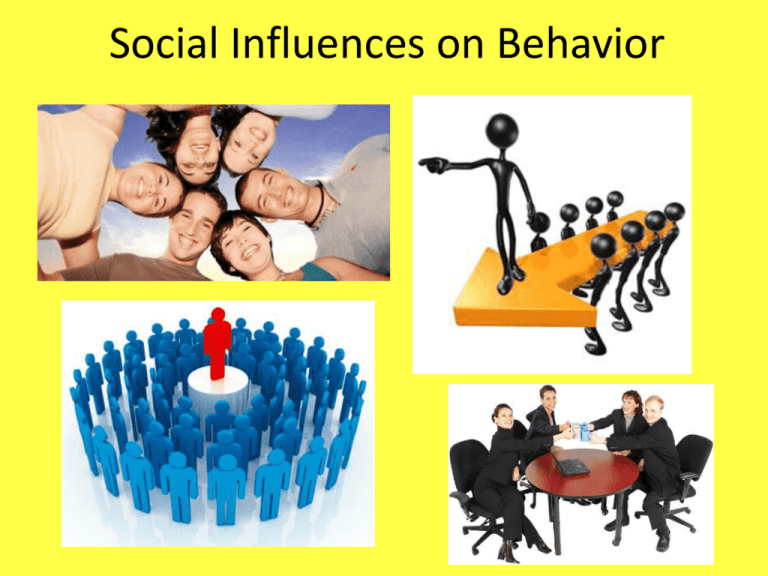
Social Influences on Behavior Group Dynamics Humans have a basic drive to form social bonds with others. Social group – two or more individuals sharing common goals and interests, interacting, and influencing each other’s behavior. Norms – Implicit or explicit rules that apply to all members of the group and govern acceptable behaviors and attitudes Working in Groups: • You will undoubtedly work in groups throughout your entire life. • Social loafing – Exerting less effort when performing a group task than when performing the same task alone Why Does Social Loafing Happen? • People acting as a part of a group feel less accountable, so they worry less about what others think of them. • Rewards may come to group regardless of individual giving more effort • They may not believe that their contribution makes a difference. • Motivation matters! – those with lower motivational levels know that someone will pick up the slack (in a group) • HOW TO COMBAT? Offer individual evaluations. • Deindividuation Where does this happen? 1. Sporting contests – The process of losing ones’ fighting “identity” while in a group. 2. Rock concerts – We tend to do things would 3. Protests - chanting 4. Riots and Looting after not normally do when alone natural disasters (Haiti) (feel anonymous) Children in costumes that created a sense of anonymity chose to steal candy more often when they were in a group than when they were alone or had been identified by name. Social influences on motivation • Norman Triplett (1897) – Noticed bicycle racers tended to go faster when others were present – Experiment – 3 conditions: – Race alone against clock – With another cyclist, but not competing – With another cyclist, in competition • Result: went faster with another cyclist, regardless of competition – Found similar results in experiment with adolescents winding fishing reels • Robert Zajonc (or social inhibition) – “Social facilitation” vs. “Social impairment” • Presence of others increases general level of arousal • Arousal increases tendency to perform behaviors that are most dominant (the ones we know best) – Improves performance for easy, familiar tasks – Performance may suffer for hard, unfamiliar tasks Social Facilitation Social Inhibition • Group polarization – Interaction and discussion of individuals in a group with similar beliefs/attitudes tends to make these beliefs/attitudes more extreme. As a group, both the Black Panthers and the Ku Klux Klan are more extreme than the average individual in the group. • Groupthink – A pattern of thinking in which group members fail to realistically evaluate the wisdom of various options and decisions • Happens when group focus shifts from objectively evaluating decisions to maintaining the group • The group moves from prove why we should do this TO why we shouldn’t do this I know what we’re going to do today… Ways to Minimize Groupthink • Avoid isolating the group – Bring in outside experts • Critical evaluators / Devil’s advocate – Role is to question assumptions and uncontested information • Open climate – Leader invites and accepts divergent thinking • Avoid being directive – Strong leaders speak last or sometimes not at all Power of Individuals The power of social influence is enormous, but so is the power of the individual. • Non-violent fasts and appeals by Gandhi led to the independence of India from the British. Margaret Bourke-White/ Life Magazine. © 1946 Time Warner, Inc. • Gandhi Minority Influence • Minority influence refers to the power of one or two individuals to sway majorities. • Remember that a third of the individuals in Milgram’s study resisted social coercion. • They have a consistency in the expression of their views. • Examples: – Gandhi, MLK Jr., Rosa Parks – An unarmed individual single-handedly challenged a line of tanks at Tiananmen Square.
